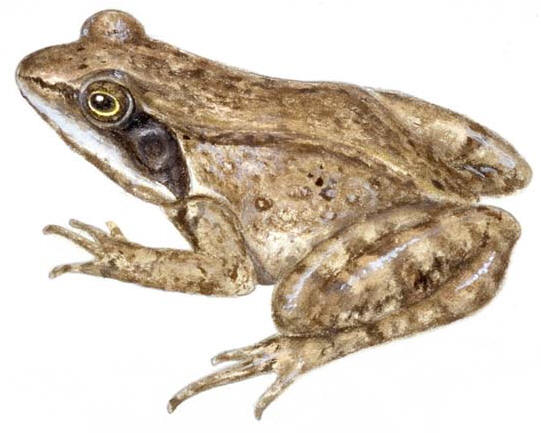
The sounds of spring are reverberating throughout the woodlands. Now we mostly hear spring peeper calls. But in some areas, interspersed in the peeper chorus is a series of short raspy quacks. This is the unique call of the wood frog. Wearing a mask and slightly bigger than the spring peeper, this little creature is so incredibly adapted that it can live above the Arctic Circle. Wood frogs inhabit the woodlands eating a wide variety of insects and other small invertebrates. In the late fall, it crawls beneath the forest floor's leaf litter and goes into a hibernation-like state. Over wintering on dry land and above the frost line would kill most cold-blooded vertebrates. But the wood frog is unique in that it can survive being frozen solid
-
a frog-sicle! In the very early springtime, it emerges from hibernation and immediately gets to the business of breeding. These otherwise solitary animals

congregate in the large woodland puddles created by snow melt and spring rains called vernal pools. There they mate and lay their eggs in large blobs called mats (see photo) usually attached to some form of vegetation. The eggs become coated in symbiotic algae that helps give oxygen to the developing embryo. This makes them easily mistaken for clumps of algae. Depending on the temperature of the water, the egg to tadpole to frog metamorphosis could take from 50 - 120 days. This fast development is necessary as most vernal pools dry up before summer. If you would like to learn how this frog survives freezing see:
http://www.youtube.com/watch?v=Fjr3A_kfspM or type "freezing frog" into You Tube's search.
 The sounds of spring are reverberating throughout the woodlands. Now we mostly hear spring peeper calls. But in some areas, interspersed in the peeper chorus is a series of short raspy quacks. This is the unique call of the wood frog. Wearing a mask and slightly bigger than the spring peeper, this little creature is so incredibly adapted that it can live above the Arctic Circle. Wood frogs inhabit the woodlands eating a wide variety of insects and other small invertebrates. In the late fall, it crawls beneath the forest floor's leaf litter and goes into a hibernation-like state. Over wintering on dry land and above the frost line would kill most cold-blooded vertebrates. But the wood frog is unique in that it can survive being frozen solid - a frog-sicle! In the very early springtime, it emerges from hibernation and immediately gets to the business of breeding. These otherwise solitary animals
The sounds of spring are reverberating throughout the woodlands. Now we mostly hear spring peeper calls. But in some areas, interspersed in the peeper chorus is a series of short raspy quacks. This is the unique call of the wood frog. Wearing a mask and slightly bigger than the spring peeper, this little creature is so incredibly adapted that it can live above the Arctic Circle. Wood frogs inhabit the woodlands eating a wide variety of insects and other small invertebrates. In the late fall, it crawls beneath the forest floor's leaf litter and goes into a hibernation-like state. Over wintering on dry land and above the frost line would kill most cold-blooded vertebrates. But the wood frog is unique in that it can survive being frozen solid - a frog-sicle! In the very early springtime, it emerges from hibernation and immediately gets to the business of breeding. These otherwise solitary animals  congregate in the large woodland puddles created by snow melt and spring rains called vernal pools. There they mate and lay their eggs in large blobs called mats (see photo) usually attached to some form of vegetation. The eggs become coated in symbiotic algae that helps give oxygen to the developing embryo. This makes them easily mistaken for clumps of algae. Depending on the temperature of the water, the egg to tadpole to frog metamorphosis could take from 50 - 120 days. This fast development is necessary as most vernal pools dry up before summer. If you would like to learn how this frog survives freezing see: http://www.youtube.com/watch?v=Fjr3A_kfspM or type "freezing frog" into You Tube's search.
congregate in the large woodland puddles created by snow melt and spring rains called vernal pools. There they mate and lay their eggs in large blobs called mats (see photo) usually attached to some form of vegetation. The eggs become coated in symbiotic algae that helps give oxygen to the developing embryo. This makes them easily mistaken for clumps of algae. Depending on the temperature of the water, the egg to tadpole to frog metamorphosis could take from 50 - 120 days. This fast development is necessary as most vernal pools dry up before summer. If you would like to learn how this frog survives freezing see: http://www.youtube.com/watch?v=Fjr3A_kfspM or type "freezing frog" into You Tube's search.




No comments:
Post a Comment